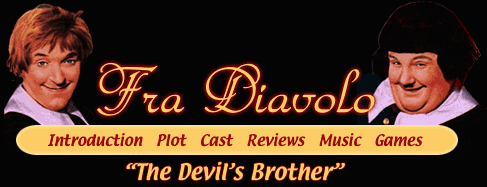|
 hat do you mean 'come easy, go easy?' Now we
have to start all over again right at the bottom! hat do you mean 'come easy, go easy?' Now we
have to start all over again right at the bottom!

Reviews
The review that follows was written
following a preview of the film. As a result of such
reviews, the final film was cut by nearly a half hour, to
9-reels.
Variety, March 24, 1933
This 11-reeler has sufficient Laurel
& Hardy and connecting story to cut down to six spools
and get an entertaining L&H feature, thus eliminating
the slow and old-fashioned opera that has been recorded
probably in the manner of its initial presentation in
1830.
The second deluge of musical pictures is
just starting, but if many more 'Fra Diavolos' are made and
released in the footage this was screened for preview
audiences, the musical deluge will only be a short summer
shower.
Too much of the original music is
retained and too little of the lyrics are heard. Settings
and ensembles are stage-like and a.k. Nothing is done with
camera or crowd manipulation to improve the original. The
L&H tempo, always ponderous, permeates the rest of the
action, making it a stroll throughout.
The comic team dish up some hearty
sequences, notably a sleeping powder gag, wine cellar scene
and laughing gag. Henry Armetta foils well for them, as does
Dennis King, who sings and plays the title part with dash
and ability. Thelma Todd looks her most seductive opposite
him. The more spiritual love element is kicked somewhere in
the background and is handled by Lucille Brown and Arthur
Pierson. James Finlayson is Miss Todd's nearsighted husband
and is good, too.
Leroy Shields has arranged and conducted
the music, a tough job capably done. Only interpolation in
the L&H cookoo trademark. Photography is underlighted in
many spots and otherwise handicapped by the 10-20-30
exterior sets.
Picture is underway 15 minutes before
Laurel and Hardy make their initial appearance.
[ Introduction |
Plot | Cast
| Reviews |
Music |
Games ]
| 
